Discover Four Historic Neighbourhoods in Colombo, Sri Lanka with Locally Handcrafted Maps
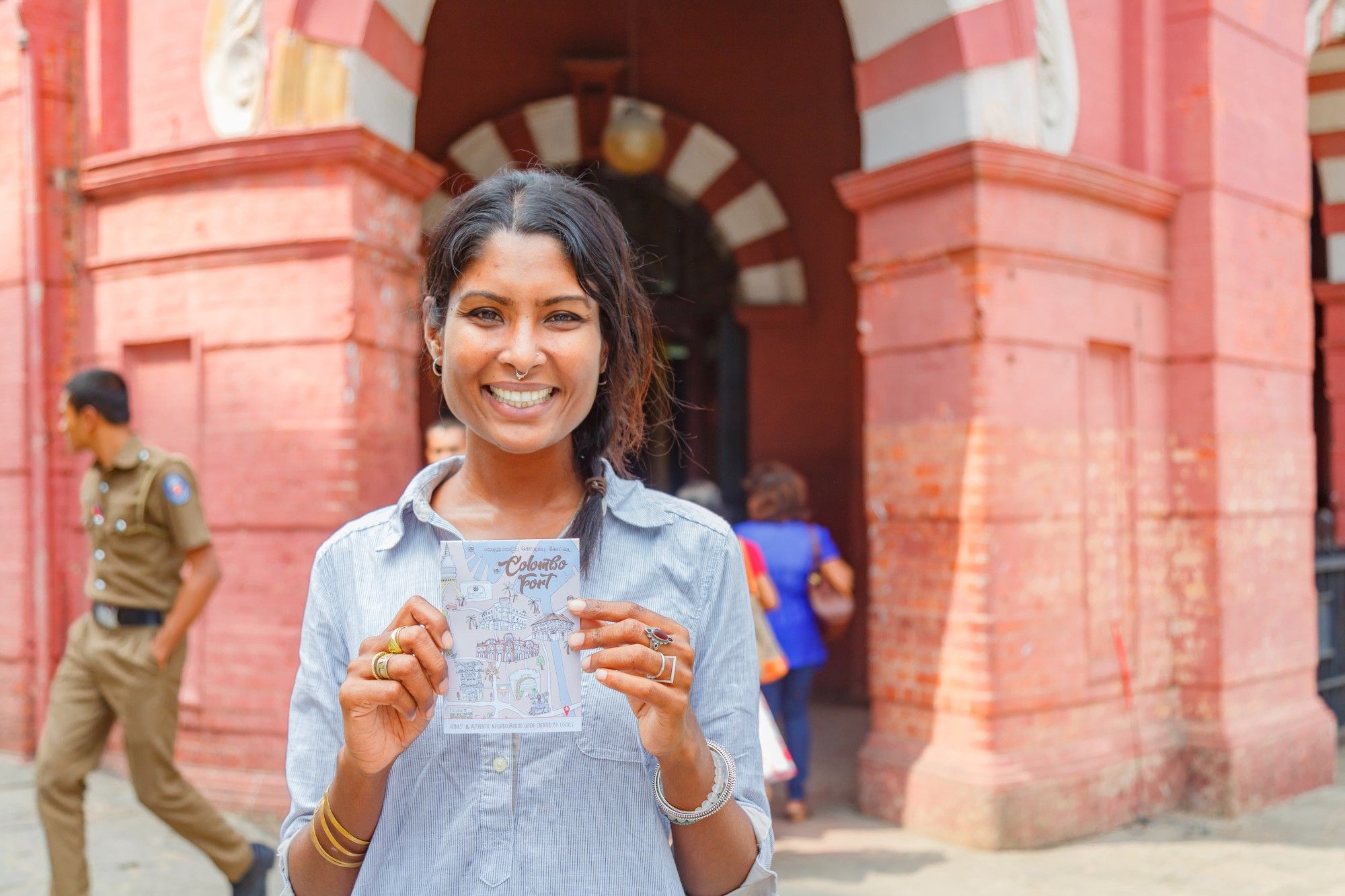
Colombo is a gem of a city. Sri Lanka’s capital is leafy, green, and surprisingly walkable. Its historic neighbourhoods make for a particularly enjoyable stroll; the pavements are wide, and old-school portico-style arcades and giant banyan trees shield you from the sun. It’s easy to get lost in the busy streets and little laneways, but that’s how you stumble upon the most surprising sites and find unexpected encounters that make for unforgettable experiences.
The Colombo Heritage Collective, a passionate group of heritage enthusiasts, created a series of new walking maps for the city’s four most iconic neighbourhoods: Fort, the historic heart of the city; the ever-bustling street market quarter of Pettah; the leafy suburb Cinnamon Gardens and the multicultural district of Slave Island.
In each neighbourhood, they roamed the streets collecting stories of places and people. They curated a charming sampling of undisputed city highlights and little-known local insights, must-see places and hidden gems, which they handcrafted into four walking itineraries of about one hour.
Four talented local artists then mapped these captivating places in their own style. The result is a series of four handcrafted neighbourhood walking maps, each a unique, artistic ode to the spirit of Colombo. We meet these four creative minds to find out more about what inspires them, what makes the city tick, and, of course, their favourite places to eat, drink, shop, pray and play in Colombo’s historic hotspots.
Even if you only have a couple of hours to spend in Colombo, their itineraries will help you catch some of the best parts of the city and help you see its multifaceted neighbourhoods through the lens of locals.
Colombo 01 . Fort . by Mika Tennekoon
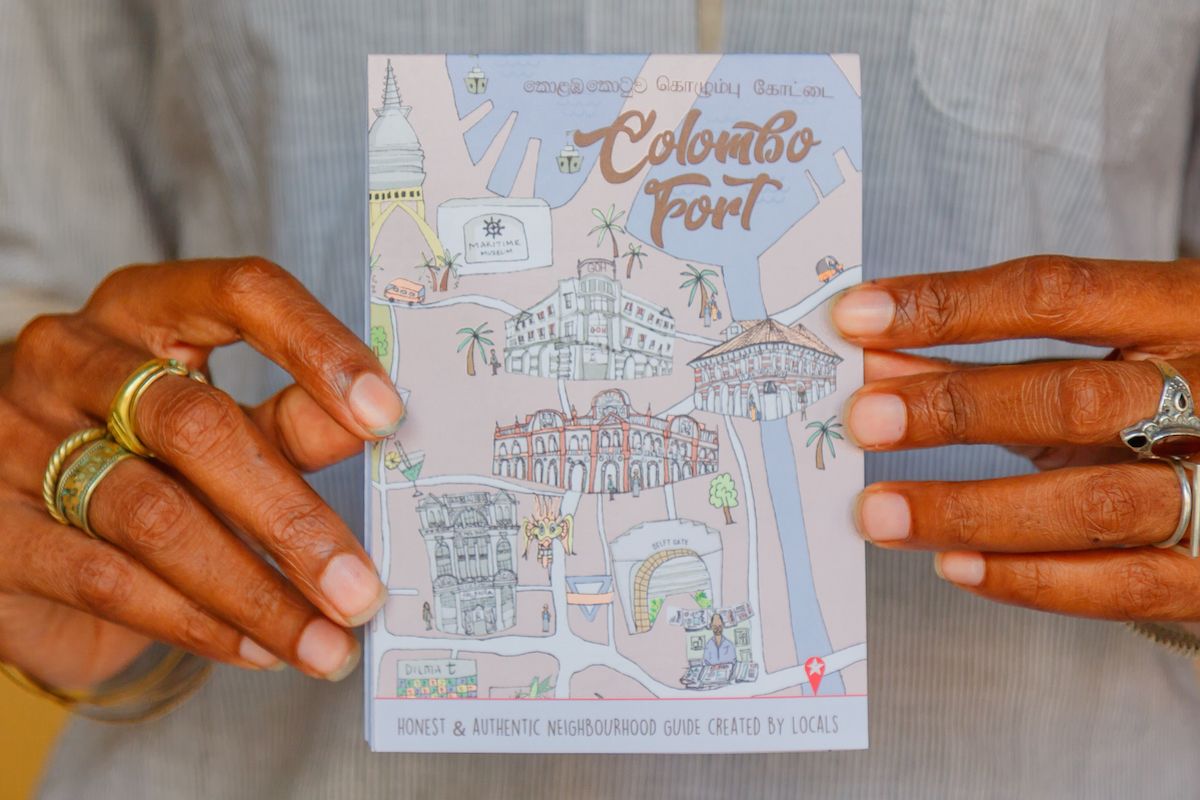


Why did you choose pastel colours for your Colombo Fort map?
Most of my work is bright and colourful, but I felt that a lighter pastel palette better fit the long history and the grand architecture of this neighbourhood. Before I started drawing, I spent an evening driving around Fort to feel the atmosphere and see how much had changed over the years. The streets were quiet, and it was a good opportunity to reconnect with the place and look at the buildings in all their splendour: so handsome and sturdy but ignored and neglected for many years.
Please tell us how your drawings capture the spirit of place.
I remember coming here as a child. My dad brought us to the Bank of Ceylon, which used to be the highest building in town. We took the elevator, one of those old ones with steel shutters, all the way up to the top floor with the elevator, which made a huge impression on me. Fort Station is also a memorable place for me; we’d take the train up-country from there. Each individual illustration is a hand-drawn memory of place. For example, I always saw a newspaper guy on the way to the station. I so vividly remember his face, and he’s now immortalised on the map. I don’t think my generation fully realises what a happening place this must have been in the old days. Since working on this project, many people have shared their Fort memories with me, such as fun picnics in Gordon Gardens, live bands playing in Grand Oriental's bar, and long nights out in Chatham Street.
What does Fort mean to you?
I have been away from Sri Lanka for a few years; I was in the UK, Vietnam, and India. Since returning, I noticed that Fort has had a ‘face-lift’. All these crumbling buildings are now being renovated; they look so fancy now, which is amazing. It’s like Colombo people start appreciating the history hidden amid all these new skyscrapers. I hope Fort’s beauty and character can be conserved, and we will not see more high rises in this part of town.
Finally, we would love to know some of your favourite places in Colombo.
I used to come to Fort a lot in the days that it was more of an off-limits place. The little terrace bar at the Grand Oriental was one of these hidden places; few people knew about it, but it had cheap beer and the best view in town. But perhaps my all-time favourite place is the Galle Face Green. I love going there for the isso vade (spicy prawn fritters, red.), enjoying the breeze and the relaxed atmosphere. I must have photographed the view a thousand times. While working on this map, I added a new place to my list of favourites. I knew of the Sambodhi Chaithya (a Buddhist stupa, red.) but I’d never been inside. The curved walls with Buddhist murals are absolutely stunning; it's a must-see!
Colombo people have started appreciating itshistory amid all these new skyscrapers. I hope the beauty and character of the Fort can be conserved.
About Mika
Mika Tennekoon is a carefree and creative spirit inspired by the deep cultural traditions of her country. She’s most happy wherever there’s sun and wherever she can surf. Have a look at her work here.
DOWNLOAD MIKA'S MAP OF COLOMBO 01 FORT
Colombo 11 . Pettah . by Ruwangi Amarasinghe

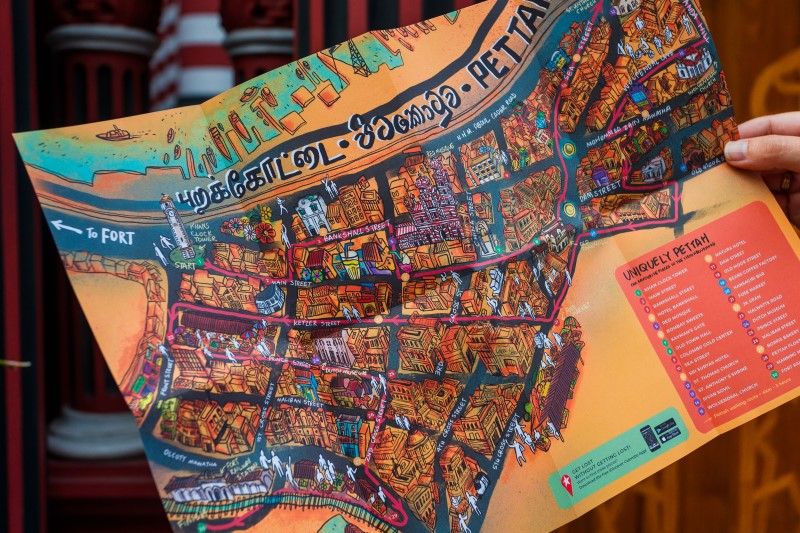
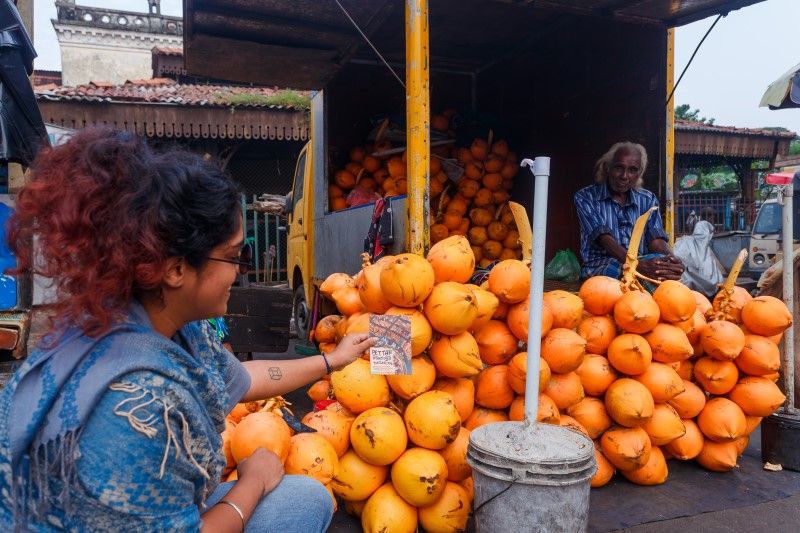
Why did you choose the orange colour for your map?
Orange is a happy, energetic colour. In Pettah, everything happens during the daytime when the sun is out; the place is hot, bold, and loud, and people are sweating and shouting. I wanted to capture that energy, the hustle and bustle of the street life here.
You’ve often drawn Pettah’s streets and buildings. Why are you so fascinated with this neighbourhood in particular?
I connect to the place. I can relate to the chaos; it’s messy but in a good way, a kind of chaos like the one in an artist’s mind... I’ve been coming to Pettah since I was a child, but I only started truly registering the place when I was at art school. At the Academy of Design, we’d come here all the time to get paper, paint and other art supplies. I rediscovered the place and fell in love with it: I learned to navigate the streets and found so many interesting places. I love observing people, and in Pettah, there’s always something going on; its beauty is in the small things, and there are so many stories to tell.
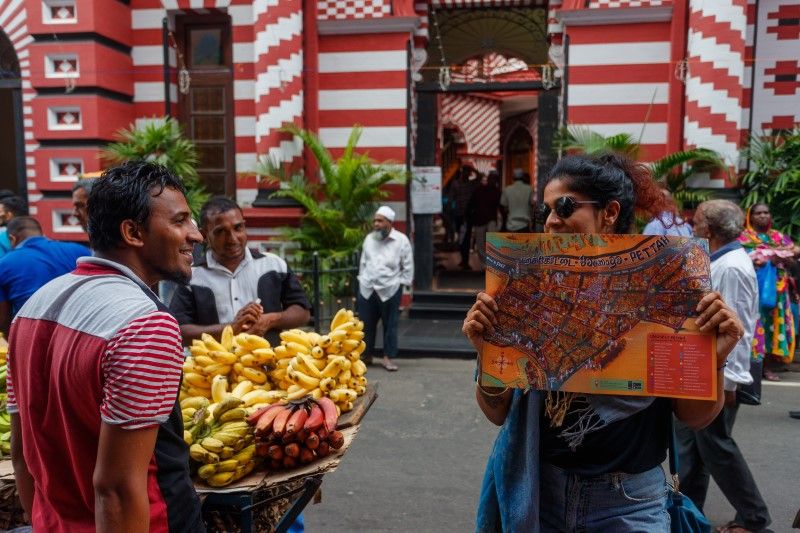
Your map is very detailed; how did you do that?
I used Google Maps Street View to see what each building looks like at street level. Zooming in and out takes a lot of time, but drawing the street scenes was fun. I had illustrated one street before but never the whole neighbourhood.
What are your favourite places in Pettah?
I always go to Bombay Sweets when I’m here, the original shop at 1st Cross Street. Their samosas are the best. And as an artist, I love browsing the stationary, paper and art supplies shops; I never leave empty-handed. I love how Pettah stays the same, but at the same time, there’s always something new to see or do, like a new shop opening in a little alleyway or new gadgets being on offer. I hope that Pettah won’t change. In many other parts of Colombo, skyscrapers are replacing the neighbourhood’s old buildings. Look at what’s happening in Fort and Slave Island; the places are losing their soul. Pettah is perfect the way it is.
I love observing people, and in Pettah, there’s always something going on. Its beauty is in the small things, and there are so many stories to tell.
Pettah's new map: The making of
See Ruwangi at work; this 30-second video shows her incredible skills and remarkable attention to detail.
About Ruwangi
Ruwangi Amarasinghe aka 'Roo' is a wanderer and wonderer. Her vibrant and colourful style brilliantly captures Pettah’s buzzing energy. Follow her at @roobixcube.
DOWNLOAD RUWANGI'S MAP OF COLOMBO 11 PETTAH
Colombo 02 . Slave Island . by Firi Rahman
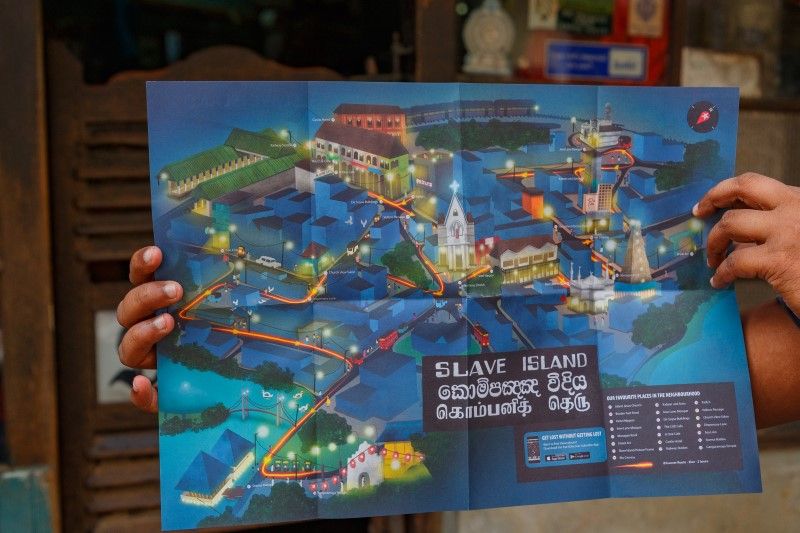
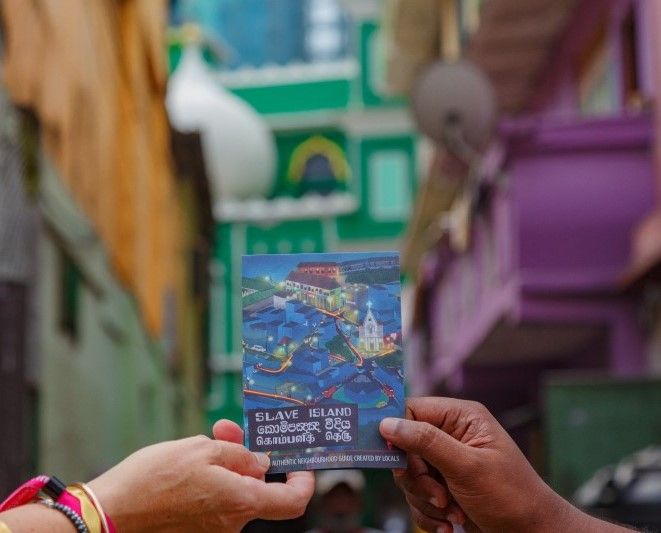
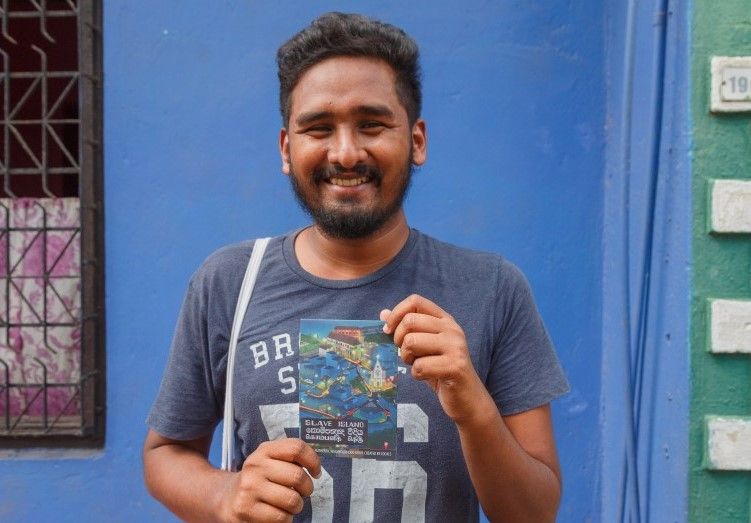
What inspired the style of your map?
I wanted to draw Slave Island by dusk; that’s when people go out to eat, pray and play, and the spirit of the place comes alive. I’ve also put in a flock of pigeons, as there are many pigeon keepers here in Slave Island. When they release the birds, it’s like they have a little party in the sky, and then they find their way back home. Every fall, when the winds come, people are up on the roofs flying their kites; it’s an amazing, colourful spectacle. I drew the temples at the Beira Lake—the famous Seema Malaka and Gangaramaya Temple—at the time of the Vesak Lantern festival in May, when there were dancers, food sellers, and beautiful light decorations.
Tell us a bit about the process of mapping this neighbourhood.
I was accompanied by a great team: writer Nadeesha Paulis and Chathura, who is a photographer. Some people we spoke to were initially a bit reluctant to share their stories, but when they started talking, they couldn’t stop; we learned so many interesting things about local family histories and past generations.
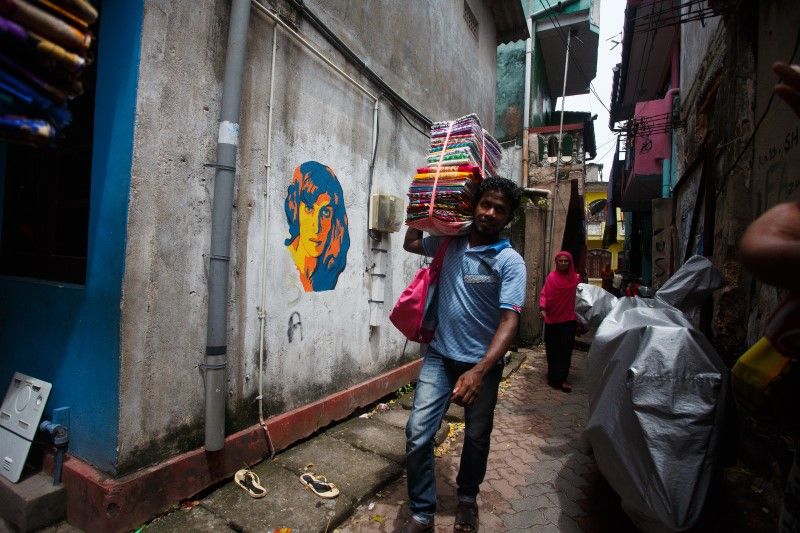
The #WeAreFromHere mural project is like a treasure hunt. I want to tell people’s stories through street art.
You live in Slave Island yourself; what are your favourite places?
Many of my favourite eateries are here, like Boolan, Kabeer & Sons and Fazly’s. What was important for me was that the old Castle Hotel was on the map—not the new one—because it was such an important place for the local community. We also wanted to document places that are disappearing from the streetscape, like the Java Lane mosque, which is still there but no longer accessible. This Malay mosque is now blocked by scaffolding from a nearby building site. And there are many more places where we don’t know whether they’ll still be here in a few years, like the famous Rio Cinema or the iconic row of De Soysa shophouses. The street has already changed beyond recognition. It’s distressing to see what’s happening; you can no longer see the sunset because of these new skyscrapers.
Why is it important to map these places now?
It’s a time of rapid change for us, and we’re all adjusting. I want to give local people the feeling that this place, its heritage and culture have value. With all these new buildings being built, they may feel that their land and properties can be bought just like that. I tell the stories of the community to make people feel proud of their place. That’s why I started the interactive mural project #WeAreFromHere with some friends. We want to show a different side of Colombo’s Slave Island community: the people who make this a fascinating, unique and diverse place and together form a multifaceted, resilient community. We paint murals of locals, sportspeople, street vendors, mechanics, musicians, actors, and artists on walls all around Slave Island. It’s like a treasure hunt, but with people! The idea is to get to know a person and find out how and why they matter to the community.
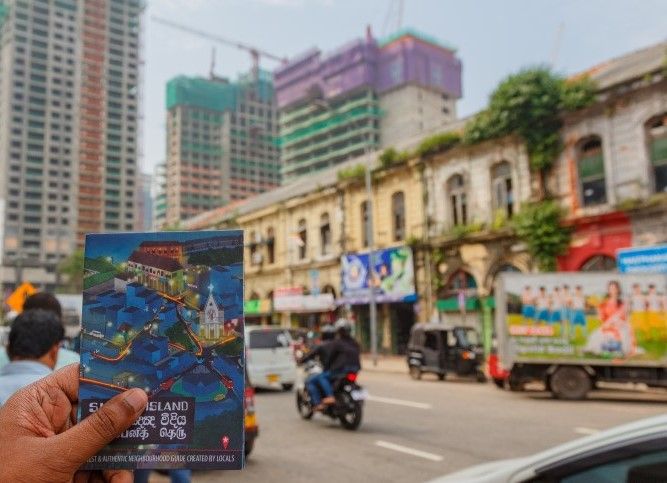
About Firi
Firi Rahman is an artist who lives and works in Slave Island. He captures the uniqueness of place in his conceptual cartography and ink pen drawings. Firi loves to wander, photograph abandoned places, and learn the stories of forgotten corners. Among his many passions is a love of parrots: “I live in my own urban jungle”. Follow him at @ifiri
DOWNLOAD FIRI'S MAP OF COLOMBO 02 SLAVE ISLAND
Colombo 07 . Cinnamon Gardens . by Neesha Fernando
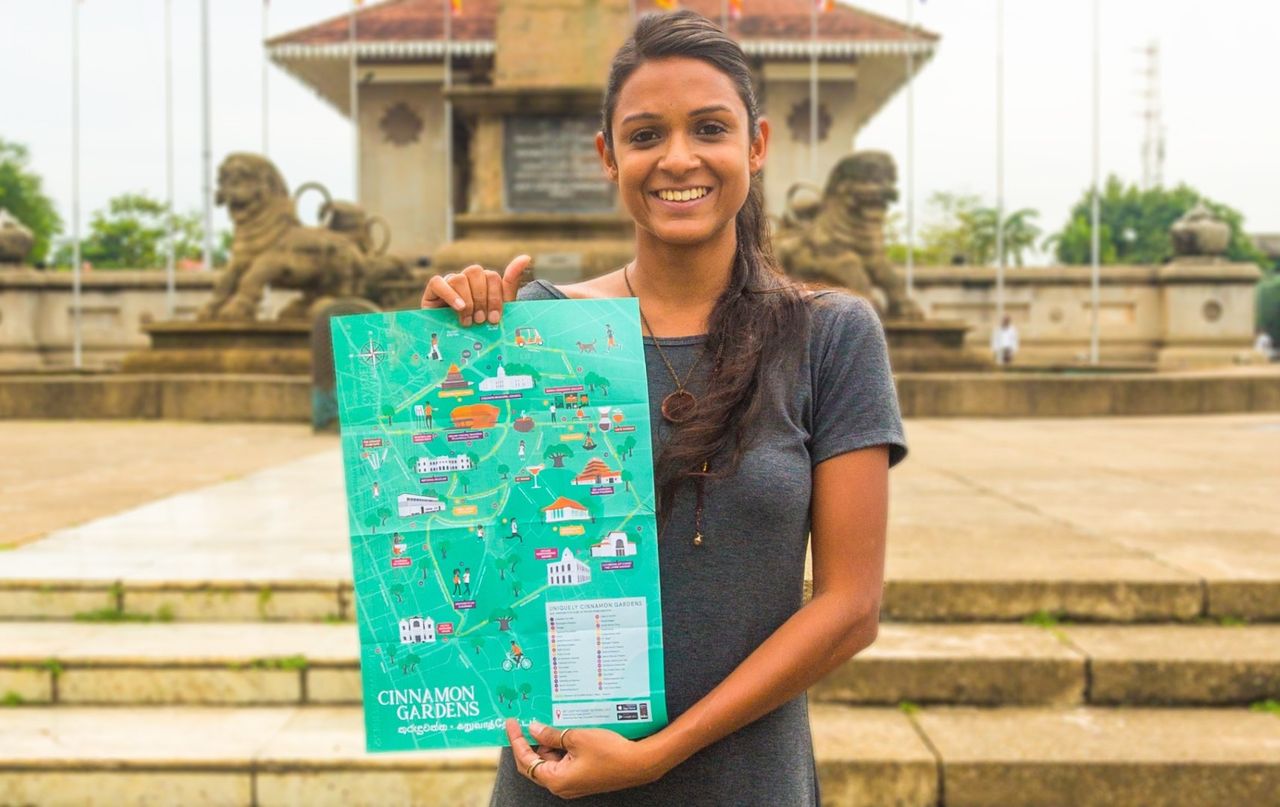
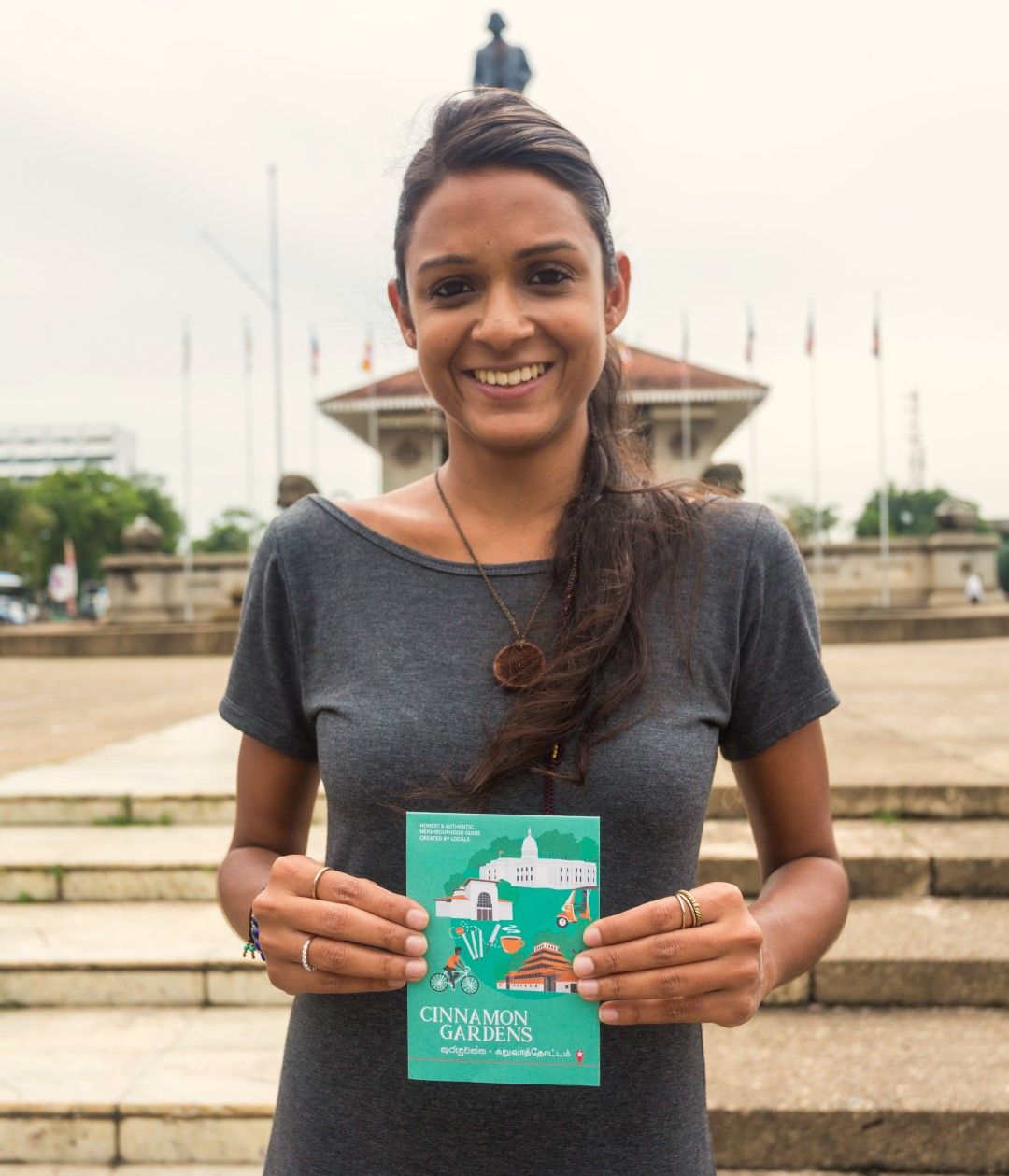

What makes Cinnamon Gardens special to you?
It’s a neighbourhood with an artistic soul. For as long as it has existed, Cinnamon Gardens or Colombo 07, has been the city’s most sought-after address. It’s home to the city’s rich, famous and cultural crowd. Along the wide boulevards, you find the major monuments, museums, and universities, as well as the city’s leading art galleries, bookshops, and theatres. Sri Lanka has always been a cultured society and Cinnamon Gardens was the country’s prime creative hub. In its many splendid villas and charming alleyways of Colombo 07, poets, painters, artists and architects met for long literary evenings, astounding exhibitions and amazing plays and concerts.
Cinnamon Gardens sounds like a very poetic place...
It once was a cinnamon plantation, so the neighbourhood is still gloriously leafy. What I love are the big open spaces. People come to Cinnamon Gardens to relax, exercise, picnic, and do yoga in the park. My favourite time is early morning when the different generations have their own fitness regimes: from running, walking and yoga to cricket and boxing—anything goes.
Should people explore Cinnamon Gardens on foot or by bike?
This is a great neighbourhood to explore by bike or tuk-tuk. Its interesting places are quite widespread, and the roads are wide and shaded. I’d go in the early morning or late afternoon.
What are your favourite places?
Recently, a bunch of new eco-friendly concept stores and organic cafés have opened in Colombo 07, like Urban Island, Good Market, Seed Café and Kumbuk Café. They sell artisanal products and yummy healthy food, which makes for totally guilt-free shopping.
About Neesha
Neesha Fernando loved drawing cartoons as a child but never dreamt she would actually have a career as an artist. As of today, she is one of Colombo’s most sought-after graphic designers. Follow her work at @justferyou.
DOWNLOAD NEESHA'S MAP OF COLOMBO 07 CINNAMON GARDENS




Mapping Dutch Fort Cities in Sri Lanka
This mapping and storytelling project in Colombo was funded by the Dutch Culture Shared International Heritage Matching Fund and is part of a bigger endeavour to unveil different historical layers in Sri Lankan coastal cities that have a shared history with the Netherlands and reinterpret stories of the past through the lens of locals.
Credits
Created by
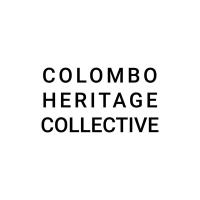
Powered by

About
Colombo Heritage Collective
Colombo Heritage Collective is an NGO that cares for Colombo’s heritage and looks for ways to preserve the city’s unique identity in a time of rapid urbanisation.
www.facebook.com/colomboheritagecollectiveDutch Culture
The Shared Cultural Heritage Fund of Dutch Culture supports projects that contribute to the visibility of the shared history that connects the Netherlands with Sri Lanka.
internationalheritage.dutchculture.nl/en